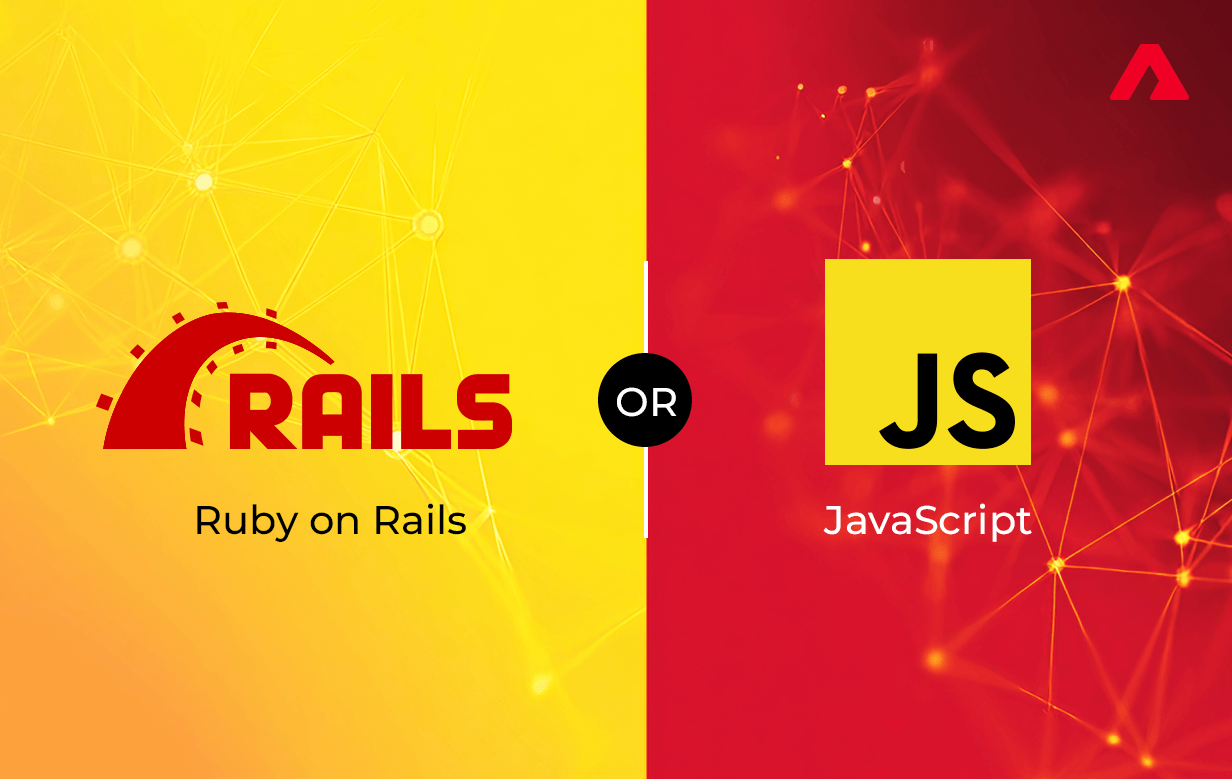An increasing demand for large-scale applications in 2025 is a struggle between ROR and JavaScript. Businesses seek to scale their operations and improve customer experience by adopting the evolving market needs. Certainly, a robust tech stack can handle performance bottlenecks of large-scale applications and deliver scalability, performance, and reliability without compromising user experience. However, choosing between JavaScript and Ruby on Rails is a critical decision and requires in-depth exploration of their suitability.
In this blog, we’ll help you gain a clear understanding of the Ruby on Rails vs JavaScript comparison, exploring their strengths, differences, and ideal use cases to help you make the right choice for your next project.
An Overview of Ruby on Rails
Ruby on Rails is a popular open-source framework designed to create server-side applications. It emphasizes Convention Over Configuration and follows the MVC architectural pattern to streamline the development process. It is considered one of the most powerful frameworks that lead to convention-driven and simplified development practices. Additionally, its clean and readable syntax and ability to handle common development tasks make Ruby on Rails a developer-friendly architecture.
ROR stands out due to its rich and innovative features, tools, and ecosystem of pre-built libraries (gems). One of its tools, Active Record, is known for simplifying working with databases by turning tables into an easy-to-use Ruby object. Whereas the scaffolding feature can speed up the development by generating basic app components automatically. The RubyGems ecosystem provides an extensive collection of reusable code packages, known as “gems,” that enhance the framework’s capabilities. These ready-to-use components allow developers to speed up the development process, reduce repetitive coding, and easily add new features without starting from scratch. Moreover, there is so much to cover that makes the process easy for developers so that they can easily add new functionality without reinventing the wheel.
Here are some key advantages and disadvantages of ROR:
Advantages –
Rapid and time-effective development –
ROR’s extensive library support allows rapid development, faster prototyping, and time-to-market.
Strong community support –
There is extensive community support behind the Ruby on Rails ecosystem. This means the gem or the feature you are using in the project is already built by someone as a plugin you can easily add. These Gems are regularly updated, so they keep getting better over time. Additionally, the Rails community actively releases tutorials, guides, and forums where developers can ask questions, learn new things, and work together on projects.
Seamless Resource Availability –
Ruby on Rails is adaptable and comparatively easier and doesn’t take long to learn. People can pick it up quickly, which makes training a replacement for your team member an easy task.
High productivity –
ROR syntax is considered developer-friendly due to its clean, readable, and concise syntax. This allows developers to focus on logic rather than writing code for boilerplate.
Unmatchable scalability –
ROR is built in a way that makes scalability easy because of its software design paradigm and the DRY (Don’t Repeat Yourself) principle. These key features let developers keep code clean and organized.
Extensive tools and libraries –
ROR seamlessly demonstrates its capabilities of robust built-in tools to organize web apps in place.
The active Rails community has already created Gems for every feature you might need so that you don’t have to create anything from scratch.
Disadvantages –
Constraints –
Ruby on Rails (RoR) is particularly effective for projects that align with common web application patterns. However, highly customized or unconventional features may require deeper modifications to their default structure and conventions, which can increase development complexity.
Runtime Speed –
ROR apps can sometimes work more slowly than apps built with lower-level languages. If the app has a lot of user base, then performance could be a concern. Also, ROR apps can take longer to boot, especially with many gem dependencies.
Documentation –
While ROR itself has good documentation, for less popular or new gems, documentation is challenging. Which can ultimately affect the development.
Multithreading –
Although ROR allows multithreading, some libraries may not be compatible with it. If Global interpreters are not managed properly, they can cause performance issues.
An overview of JavaScript
JavaScript stands as one of the most widely used and adaptable programming languages in modern web development. It empowers developers to craft interactive, engaging user experiences by manipulating web elements, handling events, and managing asynchronous tasks seamlessly.
With the rise of Node.js, JavaScript has expanded beyond the browser, becoming a powerful option for server-side and full-stack web development. Its vast ecosystem, featuring popular libraries such as React and Vue.js, supports everything from front-end interfaces to back-end systems and even mobile app frameworks.
Here are some Advantages and Disadvantages of JavaScript:
Advantages –
Lightweight Scripting Language –
This is a lightweight scripting language suitable for web browsers as it requires minimal resources and enables fast execution.
Dynamic Typing –
Working with JavaScript is easy; it does not require explicit variable declarations with data types.
Event Handling –
JavaScript handles user actions like clicks, mouse movements, and form submissions, enabling interactive website elements and dynamic content updates.
Event Handling –
JavaScript makes website elements interactive by responding to user actions and enables dynamic content updates without a full reload.
Asynchronous Operations –
JavaScript ensures a responsive and smooth user experience by handling asynchronous operations like callbacks and promises.
Object-Oriented Programming (OOP) Support –
JavaScript lets developers use OOP principles to create and manage objects that hold properties and methods.
Versatility –
It is not just compatible with frontend and backend development, but also for mobile applications.
Client-Side Scripting –
JavaScript runs in the user’s browser, enabling faster response times and interactive features without constant server communication.
Rich Ecosystem and community support –
JavaScript has extensive libraries and frameworks, tools, npm, yarn, and IDE support. This rich ecosystem leads to simplified yet dynamic development and handles complex functionalities. Additionally, it has a massive community of developers, which means faster debugging tools and an easier learning curve.
Disadvantages –
Security vulnerabilities –
JavaScript has lenient security measures because the code on the web is accessible to the client side. This code visibility makes it vulnerable to attacks, data breaches, or even leaks of sensitive information.
Debugging challenges –
Since JavaScript runs on the browser, it may not provide explicit error messages, making debugging tricky.
Callback hell –
In modern asynchronous operations of JavaScript, there are major challenges in handling network requests and user actions. The execution flow is not linear, which makes debugging difficult as errors cannot be caught at an early stage.
Browser inconsistency –
The modern browsers are standardized, but they can still interpret JavaScript differently. This necessitates constant testing and debugging across browsers that will cause complexity in the process.
Single inheritance model –
In JavaScript, an object can inherit from one parent. This makes code organization challenging, and developers often use workarounds like tricks and compositions. However, these solutions can often make the code even more complex.
Time-consuming execution –
JavaScript particularly works slowly with the DOM or on a slow network, while HTML loads quickly. This contradiction of speed in execution affects the overall user experience.
Which one fits best for your projects in 2025?
Here is a deep comparison between JavaScript and Ruby on Rails
| Features | Ruby on Rails | JavaScript |
|---|---|---|
| Type | Ruby is a programming language, and Ruby on Rails is a Framework (built on Ruby) | Programming language |
| Usage | Server-side web application development | Client-side & server-side (with Node.js) development |
| Performance | Slower runtime; better for MVPs & CRUD apps | Faster execution; ideal for dynamic, real-time applications |
| Learning Curve | Moderate (clean syntax, but convention-heavy) | Steep initially, eventually gets easy with frameworks and tools |
| Scalability | Scalable via design patterns and conventions | Highly scalable; used in microservices and event-driven apps |
| Ecosystem | Rich set of Gems and plugins | Massive with npm, countless libraries & frameworks |
| Asynchronous Support | Limited, synchronous by default | Strong with callbacks, promises, async/await |
| Community Support | Strong, but smaller than JavaScript | Extremely large and active community support |
| Security | Strong defaults (e.g., CSRF, XSS protection) | More exposure on the client side; requires careful handling |
| Flexibility | Opinionated; enforces conventions | Highly flexible; lets developers choose their approach |
| Tooling & IDE Support | Good (Rails-specific IDEs and plugins) | Excellent; supported by major IDEs and editors |
| Development Speed | Fast for prototyping and standard apps | Fast with the right tools and frameworks |
| Browser Compatibility | Not applicable (server-side) | Critical concern: must handle browser inconsistencies |
| Use Case Suitability | Best for database-driven, monolithic web apps | Best for interactive, real-time, and full-stack applications |
Ruby on Rails and JavaScript are robust technologies, and both are great choices for your projects. However, the most important things to consider are the requirements of the project and its scalability. ROR works best for server-side projects due to its well-structured architecture with strong security defaults and gem ecosystem. Besides, JavaScript is a great choice for client-side environments due to its asynchronous capabilities, huge ecosystem, and full-stack versatility.
Conclusion
For modern and fast-paced development, both Ruby on Rails and JavaScript are considered powerful technologies. ROR is a structured approach and an ideal choice for streamlined, rapid backend development. On the other hand, JavaScript remains unmatched when it comes to building interactive, scalable, and full-stack applications. ROR and JavaScript both have their pros and cons, you should choose a tech stack that aligns with your project goals.
At Atharva, we understand that choosing the right technology stack isn’t just about features; it’s about aligning with your business goals, team capabilities, and long-term vision. Whether you need help building a robust Rails application or a dynamic JavaScript-powered platform, our team of expert developers is equipped to guide you from planning to deployment. Get in touch with us to find the perfect tech fit for your next big project in 2025 and beyond.
Still unsure which technology suits your project best?
Let our experts help you evaluate your project needs and recommend a tailored solution.
Connect with us today at contact@atharvasystem.com
Visit us at https://www.atharvasystem.com to learn more.




 Insurance
Insurance


























